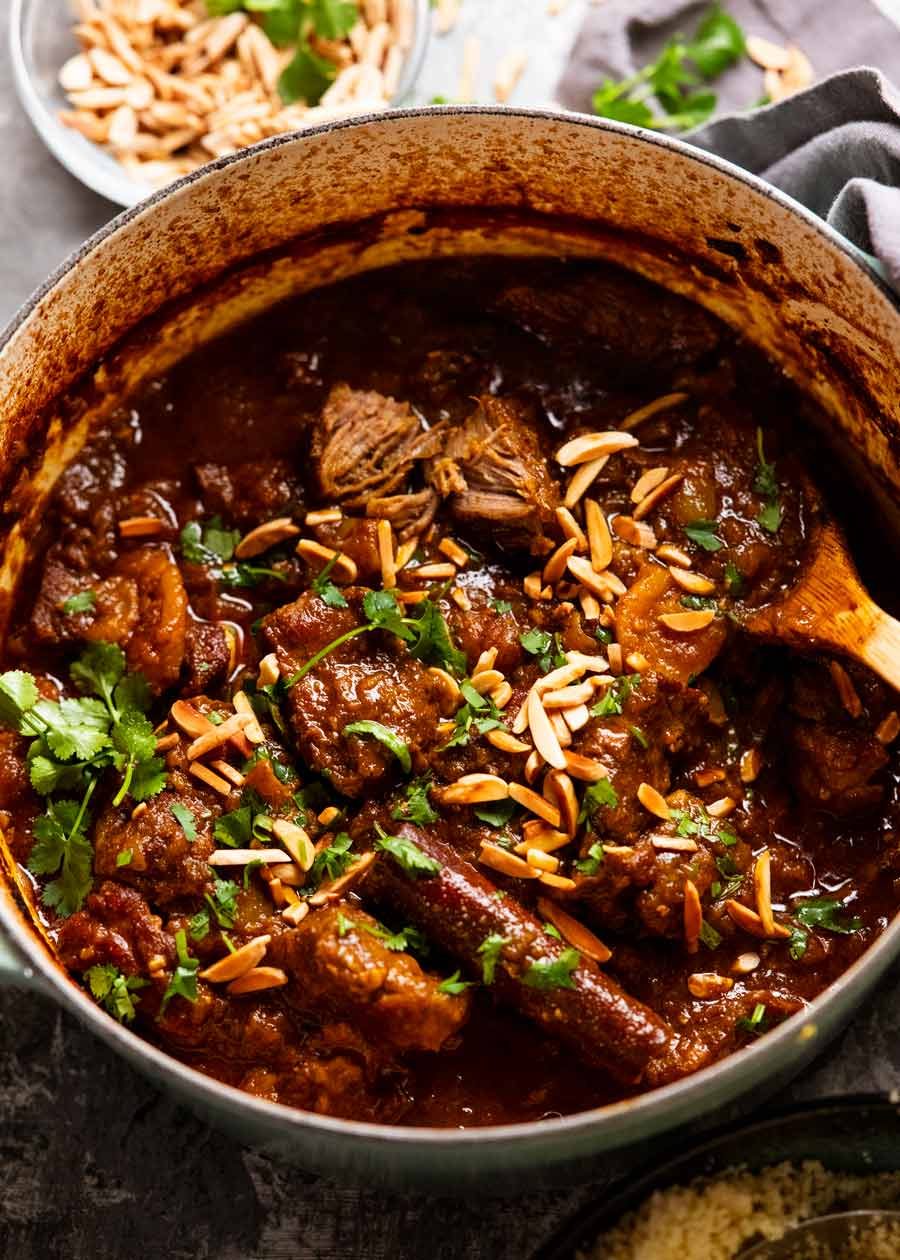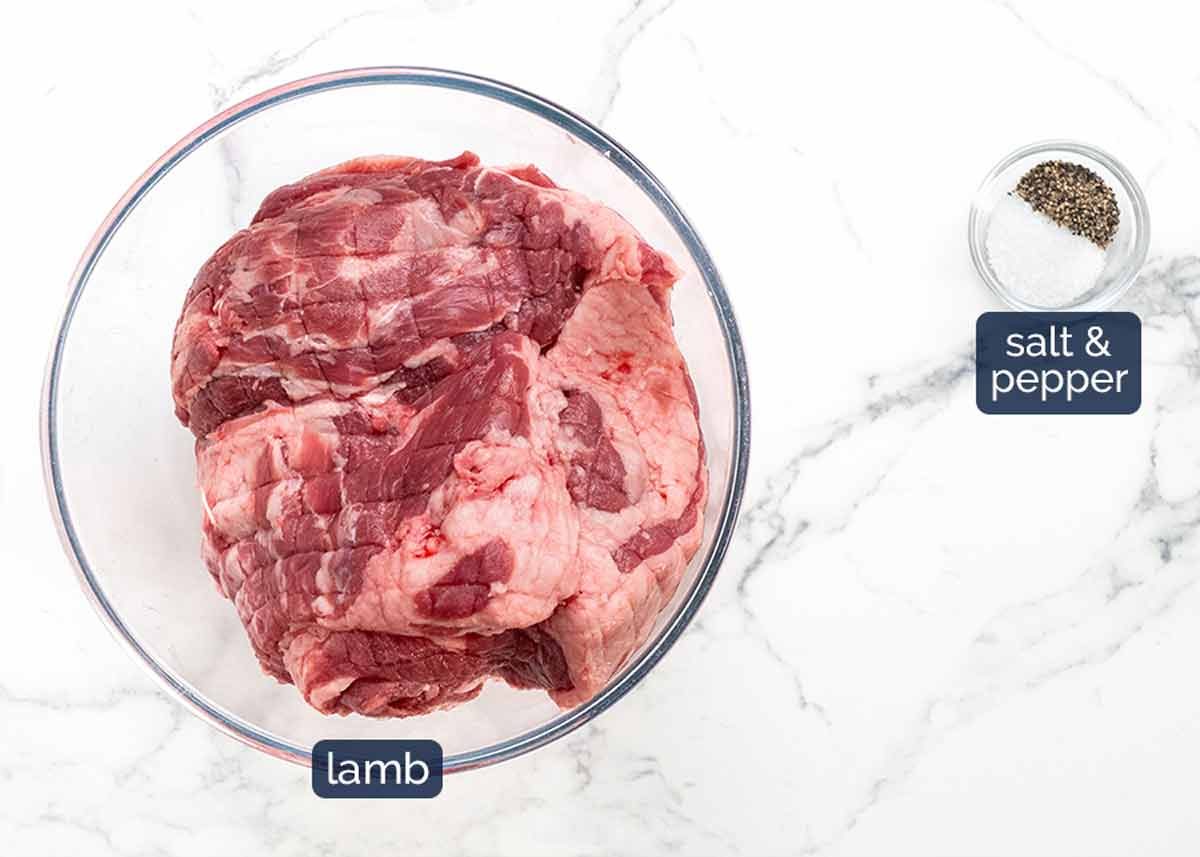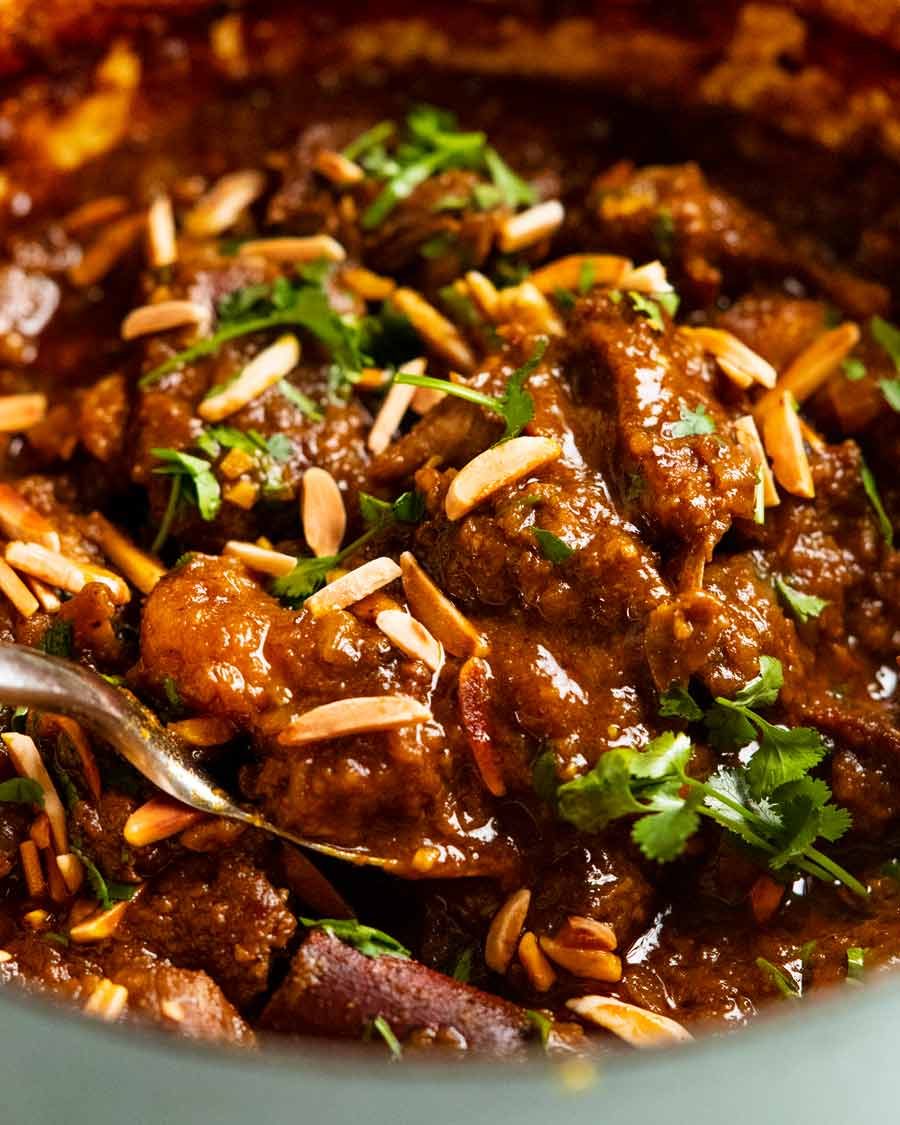Lamb Tagine is my pick of all tagines! The ras el hanout spice mix is sheer perfection with lamb, and slow cooking works wonders to develop rich flavours in the sauce. Serve over couscous for a stunning Moroccan meal. Your house will smell amazing!

Lamb Tagine
I’ve done chicken and vegetable tagine. Now it’s time to meet my favourite tagine child: LAMB TAGINE!
Arabic spice mixes and lamb are just a match made in heaven, a combination I’ve not shied away from exploring. Proof: Moroccan backstrap, Harira Soup, Shawarma shoulder, Lamb Shawarma chickpea soup, Moroccan lamb meatballs. (And all my Moroccan recipes here)
Not sure why it’s taken me so long to share the mother of all Moroccan lamb dishes – tagine. This is a stunner. Fork-tender meat, richly spiced sauce, studded with sweet apricots and finished with a good handful of toasted almonds. And the smell when it’s cooking! Swoon….

What is a tagine? “Tagine” refers to a cone-shaped cooking vessel from North Africa as well as the stew that is cooked inside. All sorts of foods are cooked in tagines, from vegetables to meat and fish. Warm spices come together with the natural juices that seep from the cooking meat and vegetables to form the sauce that makes tagines so irresistible.
Meats are often slow cooked using stewing cuts of meat to make them beautifully tender, such in as the lamb tagine I’m sharing today. On the other hand, fish tagines are much quicker to cook!
Heads up – the sauce is thick and richly spiced!
The sauce of this Lamb Tagine is reduced until thick which means intense flavour which I think is essential for lamb which is one of the stronger flavoured proteins. Think of all the spices and lamb juices reduced and concentrated – you know it’s going to be good!
Here’s what it looks like before and after the slow cooking:


Ingredients in Lamb Tagine
Here’s what you need to make Lamb Tagine.
Best lamb for tagine

The best lamb to use for lamb tagine is lamb shoulder. It’s a tough cut of meat that is made for slow cooking that’s marbled with fat so it’s beautifully juicy. Sometimes it is generically sold as “lamb stew meat”.
I personally don’t think there’s any other cut of lamb that works as well. Lamb shank meat would be the next best but you’d need to cut the meat off the bone and the shape of the pieces won’t be as uniform, so some will cook faster than others.
Boneless lamb leg would probably be my next pick but it’s leaner than shoulder so it wouldn’t be as juicy.
Other meat cuts – For non-lamb options, beef chuck, boneless beef ribs, pork shoulder and pork scotch fillet (aka collar butt and pork neck) would work well. For chicken, see my Chicken Tagine recipe, and I’ve also got a Vegetable Tagine (it’s so good!).
Ras el hanout Spice mix for lamb tagine
The spice blend for tagine is called ras el hanout and it’s made with common spices you may already have. You can buy blends but I much prefer to make my own to get the right balance of flavours. Here’s what you need:

I also use ras el hanout for chicken and vegetable tagines but the blend is slightly different. For example, because lamb has a stronger flavour than vegetables, the spice blend is stronger.
The nice thing here is that because we’re using a fair few different spices here, it’s not the end of the world if you’re missing one … or even two. I’ve offered a few switch-out options in the recipe notes!
and everything else for the tagine
And here are the other ingredients you need to make lamb tagine:

-
Garlic, onion and ginger – Aromatic flavour base. Don’t skip the ginger!
-
Cinnamon sticks – A spice traditionally used in Middle Eastern cooking and makes the flavour so special. You can substituted with a little powder but cinnamon sticks works better. It’s a little more subtle and earthier.
-
Chicken stock/broth – The braising liquid. Traditionally water is used, but stock makes it tastier! Note: Chicken stock is used rather than lamb stock because the flavour is “cleaner”. Lamb stock is not sold at grocery stores, and there’s a reason for that – because it’s very…well, lamb! We get enough lamb flavour in this sauce from the lamb pieces.
-
Dried apricots – Some versions of tagine are made with olives, others use dried fruit, others still may use both. I’ve opted for fruit because tagines are one of the few dishes I love that pairs fruit with meat! I also think the orange colour of the apricots looks lovely in the sauce.
However, the recipe includes the olive option too.
-
Tomato paste – This is what is used to thicken the sauce and add a touch of flavour. We don’t use enough to make it tomatoey, it’s very subtle.
-
Lemon – Some tagines use preserved lemon (like in my chicken tagine) but for lamb, fresh lemon zest is beautiful. Also – cheaper. 🙂
-
Slivered almonds and coriander/cilantro – Garnish for serving. A good amount of both works!
How to make Lamb Tagine
Very straight forward – brown the lamb, sauté aromatics, plonk everything in then slow cook for 1 hour 45 minutes until the lamb is fall-apart tender!

-
Brown lamb – Cut the lamb into large 3.5cm / 1.5″ cubes so they don’t become fall-apart tender too quickly. Cooking long and slow = more flavour in the sauce and it needs the time to reduce and thicken!
Toss the lamb in salt and pepper, brown in three batches (don’t crowd the pot else the lamb will stew instead of brown) then remove into a bowl.
Use a large oven-proof pot with a lid, so it can go from the stove to oven. My dutch oven pictured is 24cm / 9.5″ wide.
-
Sauté aromatics – Cook the garlic and onion first, then the tomato paste, ginger, cinnamon and spices. Cook for 1 1/2 minutes, stirring constantly, to cook out the raw flavour of the tomato paste and toast the spices which brings out the flavour.

-
Braising liquid and lamb – Add the chicken stock, water and lamb, then bring it to a simmer.
-
First cook 45 minutes – Put the lid on and transfer to a 180°F/350°F (160°C fan-forced) oven for 45 minutes.
-
Add apricots then stir them in. We add them in partway through else they get too soft.
-
Cook another 1 hour – Put the lid on then return the tagine to the oven for a further 1 hour, or until the lamb pieces are fork tender.

-
Thick and full of flavour – Here’s what the lamb tagine looks like after 1 hour 45 minutes of slow cooking. The sauce has reduced down to a thick consistency, rich with spicing and a beautiful depth of flavour you can only achieve from slow cooking.
-
Serve over couscous. I just use plain couscous for this tagine because it’s got so much flavour in it, rather than one with fruit and nuts in it.

Why the oven works best
As with any slow cooking recipe I share, I know some people will ask if it can be cooked using the slow cooker or on the stove! Unfortunately for this lamb tagine, the oven works best.
The stove wouldn’t work very well because you’d need to stir frequently to prevent the base from catching as the sauce of this tagine is considerably thicker than say, Beef Stew. But because the lamb pieces gets so tender, it will break apart into the sauce.
The slow cooker also doesn’t work that well because the sauce will not reduce nearly enough in the slow cooker. So the sauce is too thin and will lack flavour. Cooking in the slow cooker also means you don’t get caramelisation on the surface and edges of the tagine like you do in the oven and on the stove which adds flavour to stews.
For some dishes you can get around this by finishing a dish cooked in the slow cooker in the oven, like I do with Slow Cooker BBQ Brisket and Slow Cooker Roast Lamb Leg. But unfortunately not for stews like this tagine!

That close up photo above does me every time, remembering the richness of the flavour of the sauce and how tender that lamb is. Tender, but not mushy, we’re not making baby food here.
The dried apricot adds beautiful pops of sweetness as well as sweetening the sauce a touch.
And finishing with fresh lemon zest is just sheer perfection. Please don’t skip that! – Nagi x
PS Also don’t skip the good handful of toasted almonds for serving, it’s also the perfect finishing touch!
Watch how to make it
Hungry for more? Subscribe to my newsletter and follow along on Facebook, Pinterest and Instagram for all of the latest updates.

Lamb tagine
#wprm-recipe-rating-0 .wprm-rating-star.wprm-rating-star-full svg * { fill: #343434; }#wprm-recipe-rating-0 .wprm-rating-star.wprm-rating-star-33 svg * { fill: url(#wprm-recipe-rating-0-33); }#wprm-recipe-rating-0 .wprm-rating-star.wprm-rating-star-50 svg * { fill: url(#wprm-recipe-rating-0-50); }#wprm-recipe-rating-0 .wprm-rating-star.wprm-rating-star-66 svg * { fill: url(#wprm-recipe-rating-0-66); }linearGradient#wprm-recipe-rating-0-33 stop { stop-color: #343434; }linearGradient#wprm-recipe-rating-0-50 stop { stop-color: #343434; }linearGradient#wprm-recipe-rating-0-66 stop { stop-color: #343434; }
Ingredients
Use one of these lambs (Note 1):
- 1.6 kg/ 3.2lbboneless lamb shoulder, trim the fat, then cut in 3.5cm / 1.5″ cubes (1kg/2lb after trimming)
- 1 kg / 2 lblamb stewing meat or shoulder, already trimmed of fatcut in 3.5cm / 1.5″ cubes
Tagine:
- 1tspcooking/kosher salt
- 1/2tspblack pepper
- 3tbspcanola oil
- 3garlic cloves, finely minced
- 2brown onions, diced (1cm / 0.3″ cubes)
- 1 1/2tbsptomato paste
- 2tspgrated ginger
- 2cinnamon sticks
- 2 1/2cupschicken stock/broth, low sodium
- 1cupdried apricots, whole (Note 2 for olives option)
- 2 – 3tsplemon zest(just use 1 whole lemon, Note 3 for preserved lemon)
Ras el hanout (Note 4):
- 1tbspground coriander
- 1tbspground cumin
- 2tspground cardamom
- 2tspturmeric powder
- 1 1/2tspfennel powder
- 1tspcayenne pepper(can reduce for less spicy – Note 4)
- 1/4tspground cloves
- 1/4tspground ginger
- 1/2tspcooking/kosher salt
For serving:
- 1/2cupslivered almonds, toasted (Note 5)
- 1/2cupcoriander/cilantro leaves roughly chopped
- 1 1/2batchescouscous(I just use plain, but you can add the fruit and nuts if you want)
Instructions
-
Preheat oven to 180°F/350°F (160°C fan). (Note 6 re: other cook methods)
-
Spice mix – Mix the ingredients in a bowl then set aside.
-
Brown lamb – Toss lamb with the salt and pepper. Heat the oil in a large oven-proof dutch oven (with a lid) over high heat. Brown the lamb in 3 batches, turning to colour the pieces all over, about 3 minutes. Remove into a bowl, then repeat with remaining lamb. Set aside.
-
Aromatics – Turn heat down to medium high. Add onion and garlic, cook for 3 minutes until soft. Add tomato paste, ginger, cinnamon and spice mix. Cook for 1 1/2 minutes, stirring constantly.
-
Sauce – Add chicken stock and water, stir, then return the lamb into the pot.
-
Slow cook 1 hr 45 min – Bring to a simmer, cover with a lid then cook in the oven for 45 minutes. Add apricots, put the lid back on and cook for another 1 hour, checking halfway to ensure the sauce hasn’t reduced all the way (if you’re concerned, add 1/2 cup water).
-
Lemon finish – Lamb should be tender – check! Gently stir in lemon zest.
-
Serve over plain couscous, sprinkled with almonds and coriander.
Recipe Notes:
Nutrition Information:
More Moroccan stunners!
Life of Dozer
Dozer and I spent the weekend in Mudgee, a regional NSW town 3 1/2 hours from Sydney. We went for the local Readers’ Festival and dropped by the local book store (Book Nest Mudgee) as well as doing a lunch talk at a beautiful restaurant on a working farm called Blue Wren.
There was a professional photographer there so I was going to hold off until I could share those – because the venue was so stunning, everyone was frocked up, the food and wine was incredible, it was just perfection, so I want to share nice photos that do it justice! But I can’t resist sharing a few behind the scenes pics…
-
Having a serious talk with Dozer before the doors opened about not stealing food from the table:

-
At the end of the lunch, a photo with the incredible Blue Wren Farm team. And Dozer, after 5 hours of photos with lunch guests, was completely done. 😂 What a brat!!!












